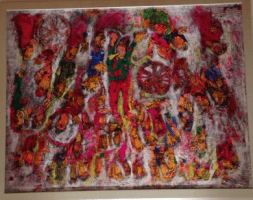 BY NADA HEDIA
BY NADA HEDIA
“Masterpieces XI” exhibition currently displays a collection of paintings and sculptures of some prominent artists and promising young talents in the Zamalek Art Gallery.
The exhibition takes place for the eleventh year, according to the gallery’s website, from Aug. 1 till Sept. 30.
It aims to present 29 young artists’ work with limited experience, along with well-known names in contemporary art such as Zeinab Al Sageny, Farouk Hosny, Farghali Abdel Hafiz and Rabab Nemr.
“A masterpiece is the greatest piece of work any artist has. Through the different arts presented in the Gallery, we hope the observer understands the true meaning of a masterpiece while connecting with the story behind every piece,” said Hani Yassin, the gallery’s financial manager.
Despite many differences, all artists have one thing in common: the ultimate love for art. Each artist portrays his or her passion differently, allowing them to create pieces that they believe could be considered as masterpieces. This makes the gallery’s collection unique and striking.
One of the artists, Ayman El-Semary, talked to the Caravan about his project as well as the selected piece included in the exhibition. His life and upbringing in the Nile Delta are clearly reflected in his project. His two-dimensional piece represents freedom in his childhood city.
“I grew up noticing the bright colored walls of the rural houses, with symbols all over them, always wondering [about] the meaning of each symbol” said El-Semary.
El-Semary explained how he›s a man stuck between the past and present. He added that he always tries to include something from his past in his present. This phenomenon is clear in his “masterpiece”.
El-Semary’s past is illustrated by the many layers of acrylic paint in his work.
This is to make sure that time does not pass by and colors do not fade away just like they did on the rural houses back in his hometown.
On top of these layers, he added a cage symbolizing the freedom he is seeking.
Hana Abdel-Wahid, an observer, thought the pieces in the gallery tackle more than one idea, pushing her to wonder and think of various things. She said that each piece is definitely interpreted differently according to the viewer’s thoughts, mood and background.
Abdel-Wahid spoke to the Caravan about El-Semary’s piece. “He is an imaginative artist, seeking to combine the past with the present to introduce historic barriers and enrich them,” she said.
Another piece, painted by George Fikry, is inspired by the social, cultural and geographical elements in Egypt. By looking at his work, one can tell that he is moved by the Egyptian environment and is deeply connected to it.
“His piece is colorful and has an apparent historic background,” said Omar El-Kerm, another observer.
Abdel Wahid and El-Kerm explained that they were moved by the art, as admiring these pieces helped them connect to the roots of the masterpieces.
They agreed that the pieces chosen for the “Masterpieces XI” exhibition are quite challenging. The artists managed to create their own descriptive language either through symbols, portraits, abstracts or even different brush strokes.
El-Semary›s last words to the Caravan were, “I can’t describe how I feel while I am painting, it›s challenging in the most beautiful way; I feel better psychologically and emotionally.”